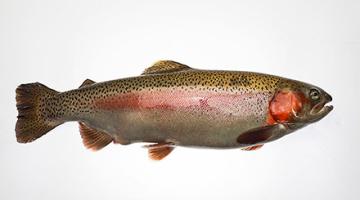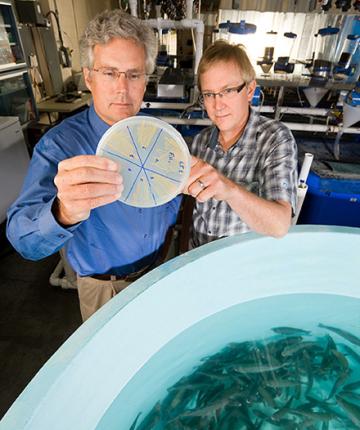Building a Better Trout


ARS researchers developed a new rainbow trout line, ARS-Fp-R, that is resistant to bacterial cold-water disease. Pictured here is a 2-year-old female from the line. (Photo by Steve Ausmus, D3908-1).
ARS Researchers are Using Cutting-Edge Genomics to Reel in Big Results
When Tim Leeds began working at the National Center for Cool and Cold Water Aquaculture (NCCCWA) in Leetown, WV in 2008, he couldn’t have imagined that ARS would someday be doing genomic selection in fish. But today, that is exactly what is happening – with impressive results. As the Research Leader of the NCCCWA, he heads a team that is using sophisticated genomic analysis to bring healthier, stronger fish to the aquaculture industry, and to your plate.
When the Center opened in 2001, it focused on selective breeding in rainbow trout using traditional techniques: raising the fish to reproductive maturity (a process that takes about 2 years), and painstakingly tracking their genealogies along with their traits. While the Center still does this type of work, researchers there are also increasingly using other techniques that can bypass the most tedious steps, learning right away whether a fish has traits they want.
They accomplish this feat by analyzing genetic markers – groups of genes they capture using breakthrough technology that has become vastly more affordable in recent years. One key tool is the SNP Chip (pronounced “snip chip”), a kind of DNA micro-array – essentially a tiny slide printed with information about an organism’s genetic sequence.
Leeds observed that, “When scientists first sequenced the human genome, it cost hundreds of millions of dollars, and now we can sequence genomes for thousands of dollars. That trickles down. Several years ago, it would have been impractical to do these chips, but they’ve become more widely available, more widely-used, and so it’s very practical now for a larger breeding program to use these technologies.”
As a result, researchers have increased the sophistication of their efforts, improving more traits more quickly than ever before. Originally, they had just focused on raising ever-larger fish.
“We made very consistent improvement, generation over generation,” Leeds explained. “But improving growth performance is a pretty straightforward trait to work on, and industry can do that themselves.”
Now, with the ability to peer into the genome of the fish, researchers can investigate traits at a much deeper level – everything from how efficiently the fish feed to their resistance to pathogens. Near the top of their list: resistance to bacterial cold water disease, a leading killer of farm-raised trout.

ARS molecular biologist Greg Wiens (left) and ARS microbiologist Tim Welch examine a culture of Flavobacterium psychrophilum, a bacterial pathogen of rainbow trout. The ARS research team at Leetown also includes geneticist Yniv Palti, computational biological Roger Vallejo, molecular biologist Sixin Liu, computational biologist Guangtu Gao and microbiologist Jason Evenhuis. (Photo by Steve Ausmus, D1944-19)
With traditional breeding methods, it had been difficult to address the illness. “How do you phenotype? That’s always the challenge,” Leeds explained, referring to the process of identifying the physical manifestations of genes in an organism.
“Getting into a trait like disease resistance is hard to do,” he said. With traditional breeding “we found that this trait was heritable” – meaning that researchers could improve it by selecting and propagating families that are most resistant. But with genomic technologies, the team can more accurately identify individual fish, not just families, that are more resistant, leading to more rapid improvement of the trait in the population. The wealth of genomic information also allows researchers to better understand actual genes and biological mechanisms that affect disease resistance. Leeds explained that disease resistance is important because antibiotics have been the main tool against disease, and by developing fish that are naturally disease-resistant, it’s possible to limit the amount of antibiotics that are used.
Leeds believes these changes will have a large impact on the aquaculture industry.
“Where this is going is, it’s not really the fish that we produce, it’s the technologies and knowledge that we produce [that matter to producers], and I say that because of the advent of genomic selection,” he said. “Our scientists developed a 57,000 [loci] snip chip for rainbow trout. It’s kind of like the 23andMe that we use in humans, just for rainbow trout. That’s a very modern and effective way to improve populations.”
In addition, because fish produce so many offspring at once, any improved trait can be spread into new populations very quickly. Leeds explained that because of the large family size and very high fecundity of fish, it is easy to amplify preferred traits.
“If you have a fish that can have 5,000 offspring vs. a litter of 12 pigs or a single calf, think about how that can expedite the amplification of truly elite genetics,” he said. “Most people think fish, well that’s worth a couple of dollars in the marketplace. But when you think about the fecundity of these fish, it’s worth investing in them to find the truly elite seedstock that can quickly be amplified and really impact the industry.”
With genomic analysis at their disposal, Leeds and his team are now equipped to do just that. – by Kathryn Markham, ARS Office of Communications.
Also in the Summer Seafood Specials series:

